A New Hybrid Synchronization PLL Scheme for Interconnecting Renewable Energy Sources to an Abnormal Electric Grid
Abstract
:1. Introduction
- The structure of the dual-mixed integrator MSTOGI involves an additional branch whose main advantage is the elimination of the DC offset of the input voltages, which is a weakness of the SOGI and TOGI integrators, without the addition of any new parameter.
- The non-adaptive MSTOGI perfectly performing the pre-filtering task overcomes the sensitivity of the classical filtering techniques to the DC offset of the grid voltage and to harmonics and inter-harmonics.
- The MQT1 technique is suggested to achieve phase locking. This technique was supported by two blocks that are responsible for compensating the amplitude error and the phase shift and correcting them independently of the frequency variation of the grid voltages.
- The coherent structure of the MSTOGI-MQT1-PLL showed promising performances in terms of the speed and accuracy of phase locking by comparing to the well-cited techniques DSOGI-PLL, CDSC-PLL, and MDSC-PLL.
2. Methods and Materials
2.1. Analysis of TOGI from SOGI Perspective
2.1.1. Basic Principle of SOGI Structure
2.1.2. Problems Experienced by SOGI
2.1.3. Structure of the TOGI
2.1.4. DC Offset Elimination Procedure Based on TOGI
2.2. Suggested MSTOGI-MQT1-PLL
2.2.1. Basic Principle of Modified Quasi Type-1 (MQT1) PLL Structure
2.2.2. Amplitude and Phase Error Compensation
3. Simulation Results and Discussion
3.1. First Scenario: Symmetrical Voltage Drop with Frequency Step Variation
3.2. Second Scenario: Distorted Grid Condition
3.3. Third Scenario: Asymmetrical Voltage Sag and Distorted Condition
4. Summary and Conclusions
Author Contributions
Institutional Review Board Statement
Informed Consent Statement
Data Availability Statement
Acknowledgments
Conflicts of Interest
References
- Yadav, R.; Pradhan, A.K.; Kamwa, I. A Spectrum Similarity Approach for Identifying Coherency Change Patterns in Power System due to Variability in Renewable Generation. IEEE Trans. Power Syst. 2019, 34, 3769–3779. [Google Scholar] [CrossRef]
- Abbassi, R.; Marrouchi, S.; Ben Hessine, M.; Chebbi, S.; Juini, H. Voltage Control Strategy of an Electrical Network by the Integration of the UPFC Compensator. Int. Rev. Model. Simul. 2012, 5, 380–384. [Google Scholar]
- Abbassi, R.; Hammami, M.; Chebbi, S. Improvement of the integration of a grid-connected wind-photovoltaic hybrid system. In Proceedings of the International Conference on Electrical Engineering and Software Applications, Yasmine Hammamet, Tunisia, 17–19 March 2013. [Google Scholar]
- Rabeh, A.; Chebbi, S. Optimal Energy Management Strategy for Wind Photovoltaic Hybrid System with Battery Storage. In Proceedings of the 16th IEEE Mediterranean Electrotechnical Conference, Yasmine Hammamet, Tunisia, 25–28 March 2012; IEEE: New York, NY, USA; pp. 810–813. [Google Scholar]
- Mohammad, R.; Sanaz, A.G.; Zahra, N.G.; Ali, M.R. An optimal and decentralized transactive energy system for electrical grids with high penetration of renewable energy sources. Int. J. Electr. Power Energy Syst. 2019, 113, 850–860. [Google Scholar]
- Rahbar, K.; Chai, C.C.; Zhang, R. Energy Cooperation Optimization in Microgrids with Renewable Energy Integration. IEEE Trans. Smart Grid 2018, 9, 1482–1493. [Google Scholar] [CrossRef]
- Glazunova, A.; Semshikov, E.; Negnevitsky, M. Real-Time Flexibility Assessment for Power Systems with High Wind Energy Penetration. Mathematics 2021, 9, 2056. [Google Scholar] [CrossRef]
- Sebastian, O.H.; Juan, M.; Felipe, F.; Enzo, S. Impact of increasing transmission capacity for a massive integration of renewable energy on the energy and environmental value of distributed generation. Renew. Energy 2022, 183, 524–534. [Google Scholar]
- González-Hernández, J.G.; Salas-Cabrera, R. Wind Power Extraction Optimization by Dynamic Gain Scheduling Approximation Based on Non-Linear Functions for a WECS Based on a PMSG. Mathematics 2021, 9, 2028. [Google Scholar] [CrossRef]
- Klemeš, J.J.; Petar, S.V.; Paweł, O.; Hon, H.C. Towards Efficient and Clean Process Integration: Utilisation of Renewable Resources and Energy-Saving Technologies. Energies 2019, 12, 4092. [Google Scholar] [CrossRef] [Green Version]
- Arora, K.; Kumar, A.; Kamboj, V.K.; Prashar, D.; Shrestha, B.; Joshi, G.P. Impact of Renewable Energy Sources into Multi Area Multi-Source Load Frequency Control of Interrelated Power System. Mathematics 2021, 9, 186. [Google Scholar] [CrossRef]
- Valencia-Rivera, G.H.; Merchan-Villalba, L.R.; Tapia-Tinoco, G.; Lozano-Garcia, J.M.; Ibarra-Manzano, M.A.; Avina-Cervantes, J.G. Hybrid LQR-PI Control for Microgrids under Unbalanced Linear and Nonlinear Loads. Mathematics 2020, 8, 1096. [Google Scholar] [CrossRef]
- Peng, Y.; Shuai, Z.; Guerrero, J.M.; Li, Y.; Luo, A.; Shen, Z.J. Performance Improvement of the Unbalanced Voltage Compensation in Islanded Microgrid Based on Small-Signal Analysis. IEEE Trans. Ind. Electron. 2020, 67, 5531–5542. [Google Scholar] [CrossRef]
- Jerbi, H. Estimations of the Domains of Attraction for Classes of Nonlinear Continuous Polynomial Systems. Arab. J. Sci. Eng. 2017, 42, 2829–2837. [Google Scholar] [CrossRef]
- Kchaou, M. Robust observer-based sliding mode control for nonlinear uncertain singular systems with time-varying delay and input non-linearity. Eur. J. Control. 2019, 49, 15–25. [Google Scholar] [CrossRef]
- Kchaou, M.; Houssem, J.; Rabeh, A.; Jeyamani, V.; Faical, H.; Abdallah, K. Passivity-based asynchronous fault-tolerant control for nonlinear discrete-time singular markovian jump systems: A sliding-mode approach. Eur. J. Control. 2021, 60, 95–113. [Google Scholar] [CrossRef]
- Mourad, K.; Magdi, S.M. Robust (Q,S,R)γ-dissipative sliding mode control for uncertain discrete-time descriptor systems with time-varying delay. IMA J. Math. Cont. Inf. 2018, 35, 735–756. [Google Scholar]
- Prakash, P.; Meena, D.C.; Malik, H.; Alotaibi, M.A.; Khan, I.A. A Novel Analytical Approach for Optimal Integration of Renewable Energy Sources in Distribution Systems. Energies 2021, 15, 1341. [Google Scholar] [CrossRef]
- Rárison, R.A.F.; Ricardo, F.B.; Luis, C.O.O. Harmonic distortion assessment in power distribution networks considering DC component injection from PV inverters. Electr. Power Syst. Res. 2020, 188, 106521. [Google Scholar]
- Prakht, V.; Dmitrievskii, V.; Anuchin, A.; Kazakbaev, V. Inverter Volt-Ampere Capacity Reduction by Optimization of the Traction Synchronous Homopolar Motor. Mathematics 2021, 9, 2859. [Google Scholar] [CrossRef]
- Hui, N.; Feng, Y.; Han, X. Design of a High Performance Phase-Locked Loop with DC Offset Rejection Capability under Adverse Grid Condition. IEEE Access 2020, 8, 6827–6838. [Google Scholar] [CrossRef]
- García, J.I.; Candela, J.I.; Catalán, P. Prefiltered Synchronization Structure for Grid-Connected Power Converters to Reduce the Stability Impact of PLL Dynamics. IEEE J. Emerg. Sel. Top. Power Electron. 2021, 9, 5499–5507. [Google Scholar] [CrossRef]
- Campanhol, L.B.G.; da Silva, S.A.O.; de Oliveira, A.A.; Bacon, V.D. Power Flow and Stability Analyses of a Multifunctional Distributed Generation System Integrating a Photovoltaic System with Unified Power Quality Conditioner. IEEE Trans. Power Electron. 2019, 34, 6241–6256. [Google Scholar] [CrossRef]
- Xia, S.; Bu, S.; Wan, C.; Lu, X.; Chan, K.W.; Zhou, B. A Fully Distributed Hierarchical Control Framework for Coordinated Operation of DERs in Active Distribution Power Networks. IEEE Trans. Power Syst. 2019, 34, 5184–5197. [Google Scholar] [CrossRef]
- Tareen, W.U.K.; Mekhielf, S. Three-Phase Transformerless Shunt Active Power Filter with Reduced Switch Count for Harmonic Compensation in Grid-Connected Applications. IEEE Trans. Power Electron. 2018, 33, 4868–4881. [Google Scholar] [CrossRef]
- Wang, L.; Lam, C.; Wong, M. Analysis, Control, and Design of a Hybrid Grid-Connected Inverter for Renewable Energy Generation with Power Quality Conditioning. IEEE Trans. Power Electron. 2018, 33, 6755–6768. [Google Scholar] [CrossRef]
- He, J.; Dong, Z.; Wang, Y.; Wang, C. Cost-Effective Islanded Electrical System with Decentralized Interleaving PWM for Converter Harmonic Reduction. IEEE Trans. Ind. Electron. 2020, 67, 8472–8483. [Google Scholar] [CrossRef]
- Neira, S.; Pereda, J.; Rojas, F. Three-Port Full-Bridge Bidirectional Converter for Hybrid DC/DC/AC Systems. IEEE Trans. Power Electron. 2020, 35, 13077–13084. [Google Scholar] [CrossRef]
- Hosseinzadeh, M.; Salmasi, F.R. Fault-Tolerant Supervisory Controller for a Hybrid AC/DC Micro-Grid. IEEE Trans. Smart Grid 2018, 9, 2809–2823. [Google Scholar] [CrossRef]
- Adib, A.; Lamb, J.; Mirafzal, B. Ancillary Services via VSIs in Microgrids with Maximum DC-Bus Voltage Utilization. IEEE Trans. Ind. Appl. 2019, 55, 648–658. [Google Scholar] [CrossRef]
- De Zotti, G.; Pourmousavi, S.A.; Madsen, H.; Kjølstad Poulsen, N. Ancillary Services 4.0: A Top-to-Bottom Control-Based Approach for Solving Ancillary Services Problems in Smart Grids. IEEE Access 2018, 6, 11694–11706. [Google Scholar] [CrossRef]
- IEEE Std 1547-2018 (Revision of IEEE Std 1547-2003); IEEE Standard for Interconnection and Interoperability of Distributed Energy Resources with Associated Electric Power Systems Interfaces. IEEE: New York, NY, USA, 2018; Volume 3, pp. 1–138.
- Mandal, K.; Banerjee, S. Synchronization Phenomena in Interconnected Power Electronic Systems. IEEE Trans. Circuits Syst. II Express Briefs 2016, 63, 221–225. [Google Scholar] [CrossRef]
- Thale, S.S.; Agarwal, V. Controller Area Network Assisted Grid Synchronization of a Microgrid with Renewable Energy Sources and Storage. IEEE Trans. Smart Grid 2016, 7, 1442–1452. [Google Scholar] [CrossRef]
- Ma, S.; Geng, H.; Liu, L.; Yang, G.; Pal, B.C. Grid-Synchronization Stability Improvement of Large Scale Wind Farm during Severe Grid Fault. IEEE Trans. Power Syst. 2018, 33, 216–226. [Google Scholar] [CrossRef] [Green Version]
- Huang, L.; Xin, H.; Li, Z.; Ju, P.; Yuan, H. Grid-Synchronization Stability Analysis and Loop Shaping for PLL-Based Power Converters with Different Reactive Power Control. IEEE Trans. Smart Grid 2020, 11, 501–516. [Google Scholar] [CrossRef]
- Mukherjee, S.; Chowdhury, V.R.; Shamsi, P.; Ferdowsi, M. Power-Angle Synchronization for Grid-Connected Converter with Fault Ride-Through Capability for Low-Voltage Grids. IEEE Trans. Energy Convers. 2018, 33, 970–979. [Google Scholar] [CrossRef]
- Taul, M.G.; Wang, X.; Davari, P.; Blaabjerg, F. An Overview of Assessment Methods for Synchronization Stability of Grid-Connected Converters under Severe Symmetrical Grid Faults. IEEE Trans. Power Electron. 2019, 34, 9655–9670. [Google Scholar] [CrossRef] [Green Version]
- Amardeep, B.S.; Hiralal, M.S.; Girish, G.T.; Shelas, S.; Makarand, S.B.; Vijay, B.B.; Manoj, R.R.; Madhuri, A.C. Grid Interfaced Distributed Generation System with Modified Current Control Loop Using Adaptive Synchronization Technique. IEEE Trans. Ind. Inform. 2017, 13, 2634–2644. [Google Scholar]
- Hans, F.; Schumacher, W.; Harnefors, L. Small-Signal Modeling of Three-Phase Synchronous Reference Frame Phase-Locked Loops. IEEE Trans. Power Electron. 2018, 33, 5556–5560. [Google Scholar] [CrossRef]
- Guan, Y.; Guerrero, J.M.; Zhao, X.; Vasquez, J.C.; Guo, X. A New Way of Controlling Parallel-Connected Inverters by Using Synchronous-Reference-Frame Virtual Impedance Loop—Part I: Control Principle. IEEE Trans. Power Electron. 2016, 31, 4576–4593. [Google Scholar] [CrossRef] [Green Version]
- Rodriguez, P.; Pou, J.; Bergas, J.; Candela, J.I.; Burgos, R.P.; Boroyevich, D. Decoupled Double Synchronous Reference Frame PLL for Power Converters Control. IEEE Trans. Power Electron. 2007, 22, 584–592. [Google Scholar] [CrossRef]
- Xiao, F.; Dong, L.; Li, L.; Liao, X. A frequency-fixed SOGI-based PLL for single-phase grid-connected converters. IEEE Trans. Power Electron. 2017, 32, 1713–1719. [Google Scholar] [CrossRef]
- Golestan, S.; Monfared, M.; Freijedo, F.D. Design-oriented study of advanced synchronous reference frame phase-locked loops. IEEE Trans. Power Electron. 2013, 28, 765–778. [Google Scholar] [CrossRef]
- Zhang, C.; Zhao, X.; Wang, X.; Chai, X.; Zhang, Z.; Guo, X. A Grid Synchronization PLL Method Based on Mixed Second- and Third-Order Generalized Integrator for DC Offset Elimination and Frequency Adaptability. IEEE J. Emerg. Sel. Top. Power Electron. 2018, 6, 1517–1526. [Google Scholar] [CrossRef] [Green Version]
- Golestan, S.; Ramezani, M.; Guerrero, J.M.; Monfared, M. dq-frame cascaded delayed signal cancellation-based PLL: Analysis, design, and comparison with moving average filter-based PLL. IEEE Trans. Power Electron. 2015, 30, 1618–1632. [Google Scholar] [CrossRef] [Green Version]
- Gude, S.; Chu, C. Three-Phase PLLs by using frequency adaptive multiple delayed signal cancellation prefilters under adverse grid conditions. IEEE Trans. Ind. Appl. 2018, 54, 3832–3844. [Google Scholar] [CrossRef]
- Gude, S.; Chu, C.; Vedula, S.V. Recursive implementation of multiple delayed signal cancellation operators and their applications in prefiltered and in-loop filtered PLLs under adverse grid conditions. IEEE Trans. Ind. Appl. 2019, 55, 5383–5394. [Google Scholar] [CrossRef]
- Golestan, S.; Freijedo, F.D.; Vidal, A.; Yepes, A.G.; Guerrero, J.M.; Doval-Gandoy, J. An efficient implementation of generalized delayed signal cancellation PLL. IEEE Trans. Power Electron. 2016, 31, 1085–1094. [Google Scholar] [CrossRef] [Green Version]
- Sevilmiş, F.; Karaca, H. Implementation of enhanced non-adaptive cascaded DSC-PLLs for renewable energy systems. Int. J. Electr. Power Energy Syst. 2022, 134, 107470. [Google Scholar] [CrossRef]
- McGranaghan, M.; Beaulieu, G. Update on IEC 61000-3-6: Harmonic emission limits for customers connected to MV, HV and EHV. In Proceedings of the IEEE Transmission and Distribution Conference, Exhibit, Dallas, TX, USA, 21–24 May 2006; IEEE: New York, NY, USA, 2006; pp. 1158–1161. [Google Scholar]
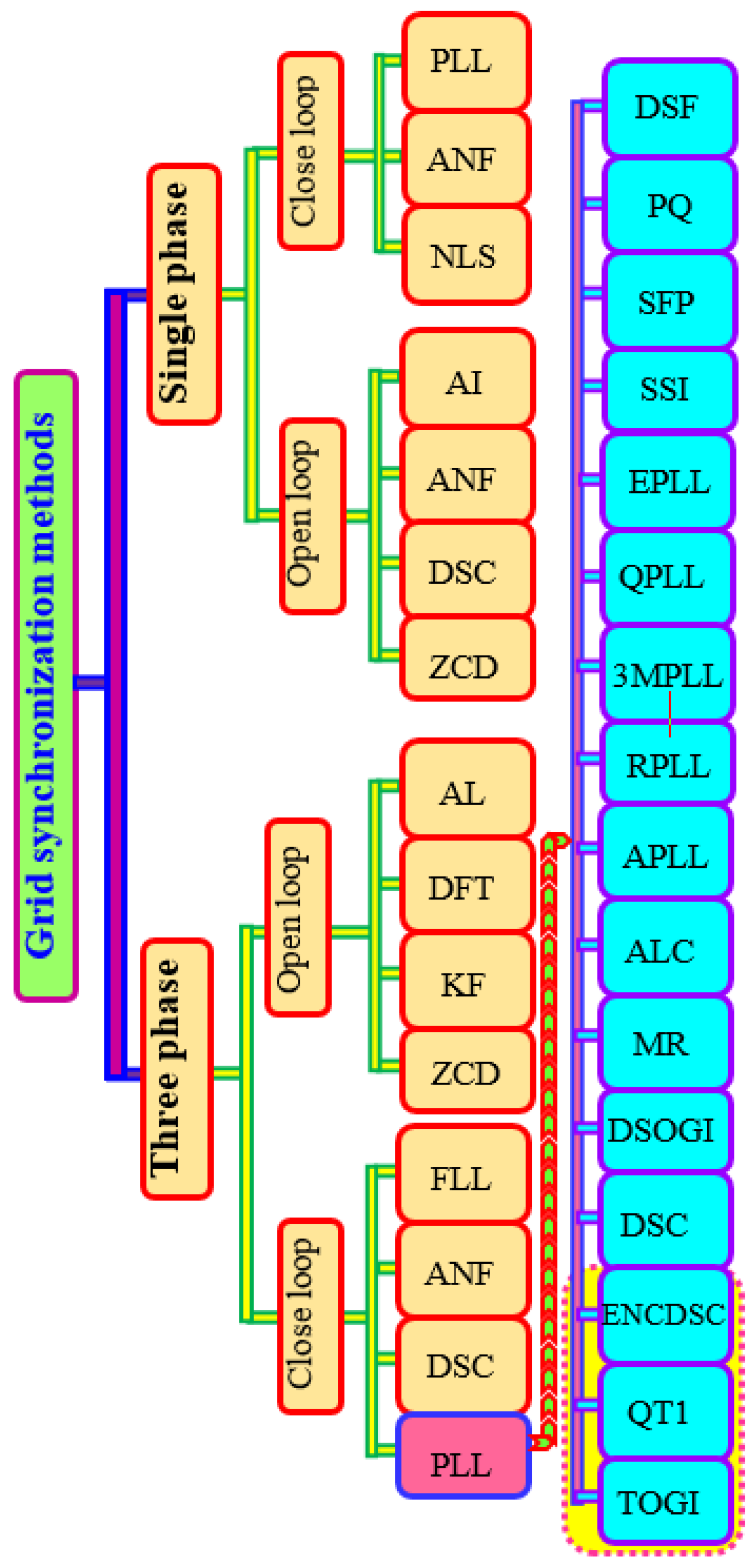



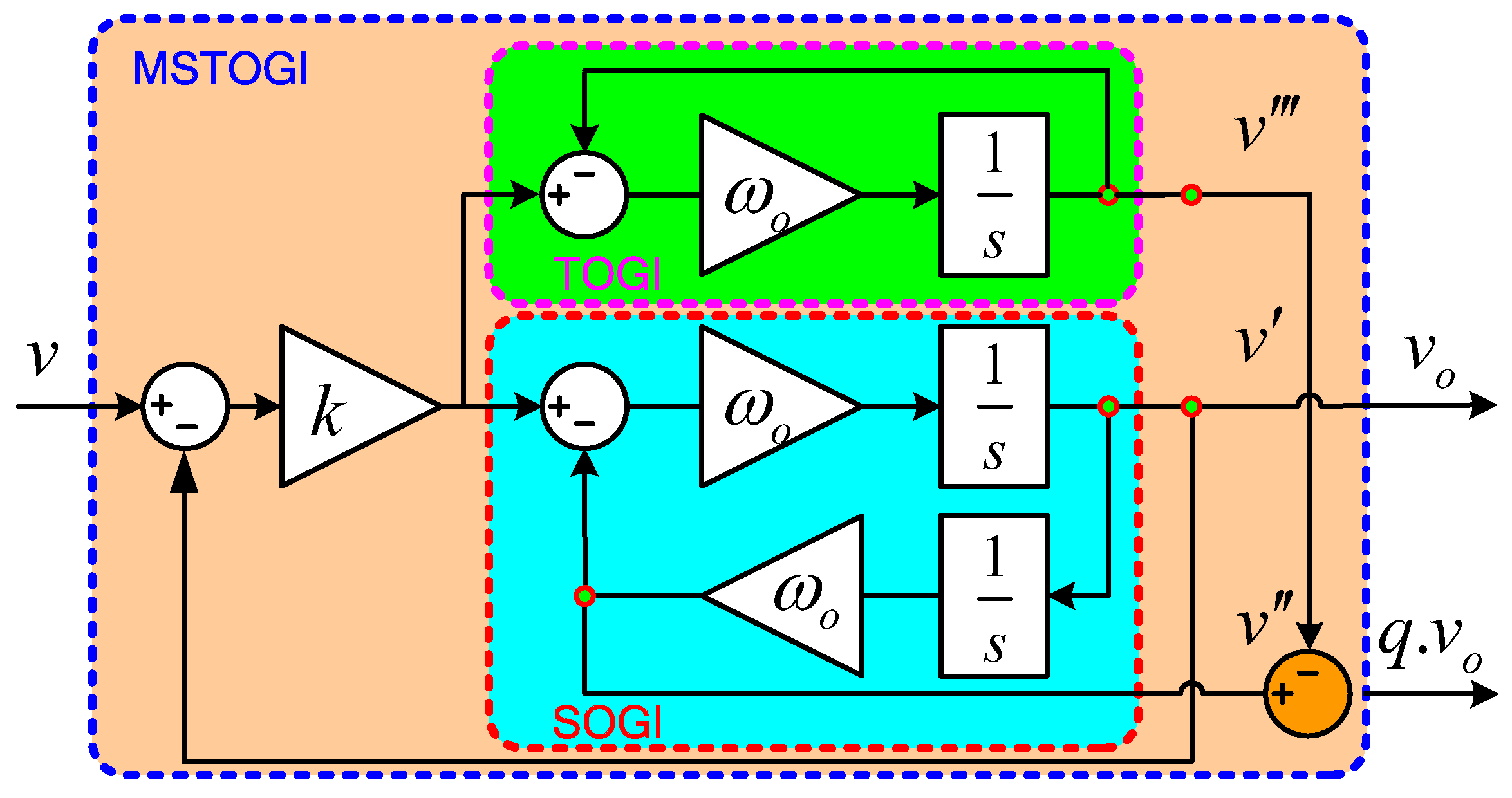
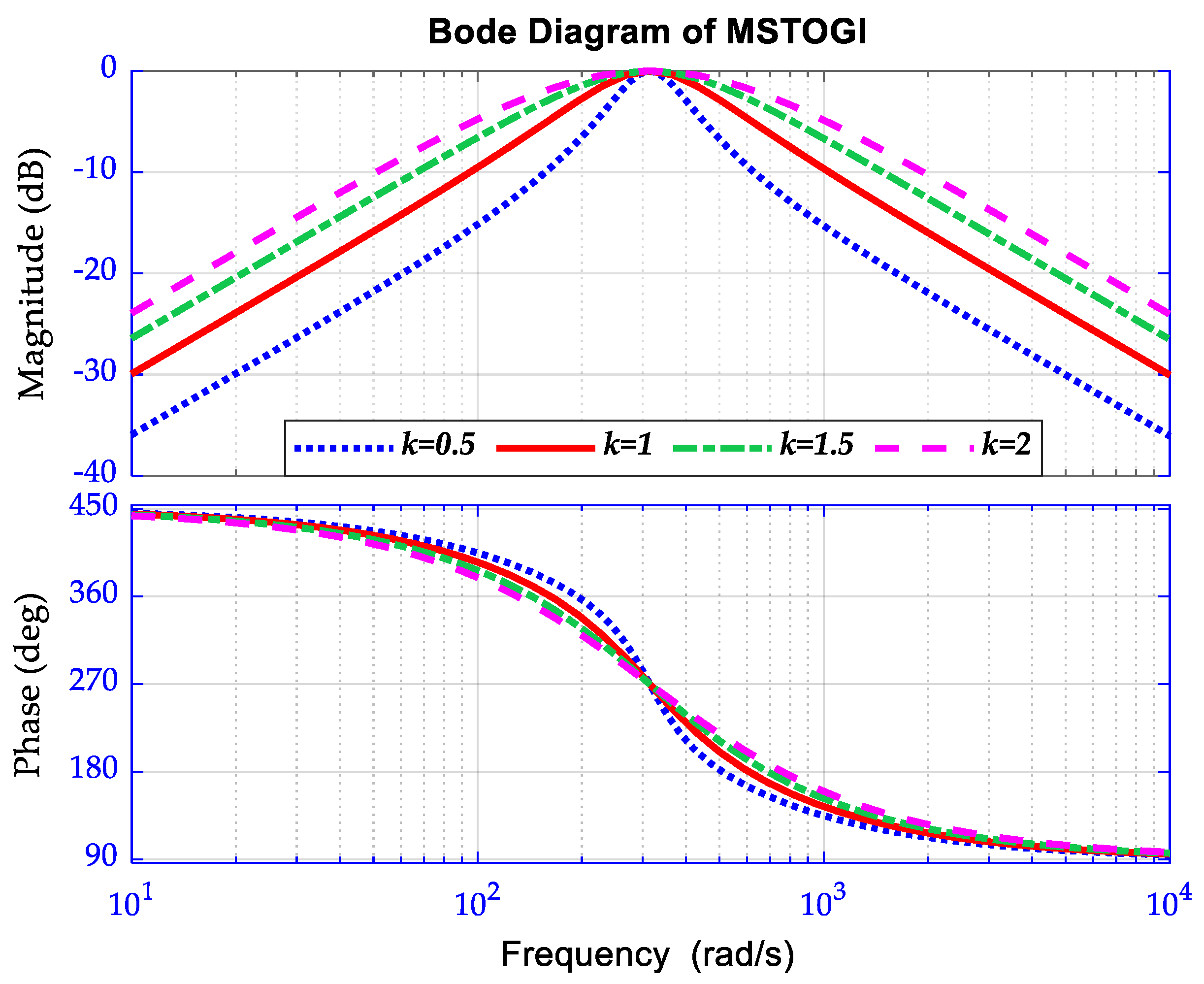
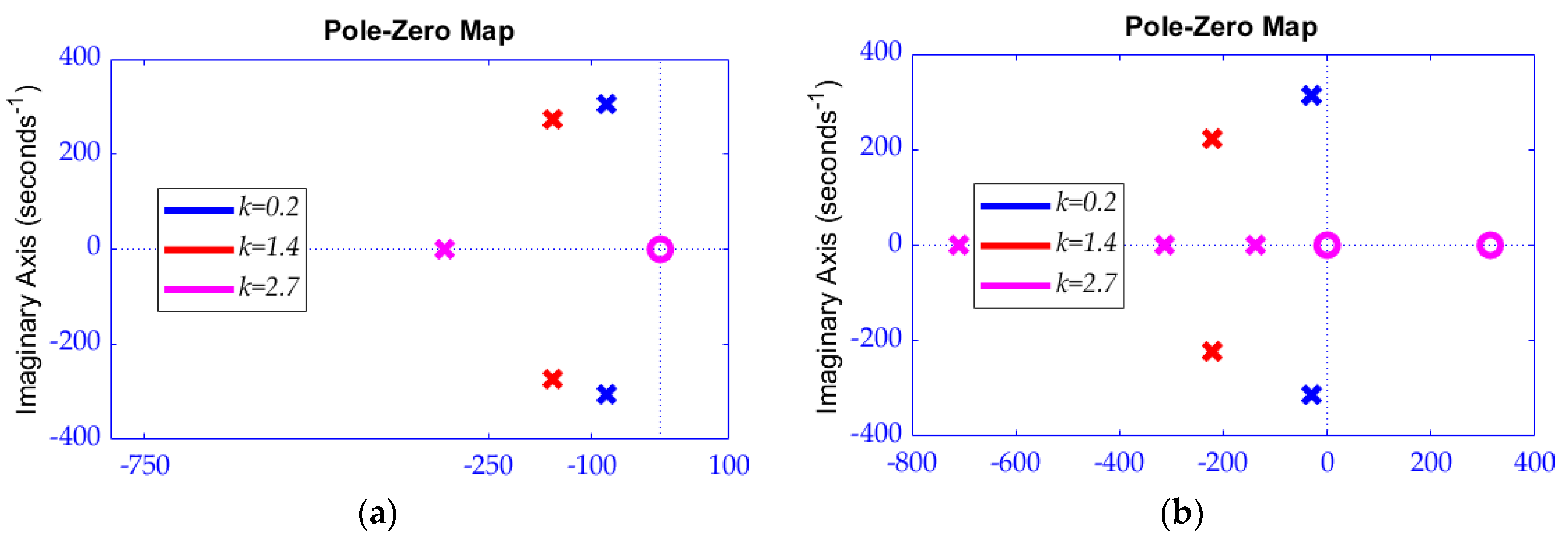
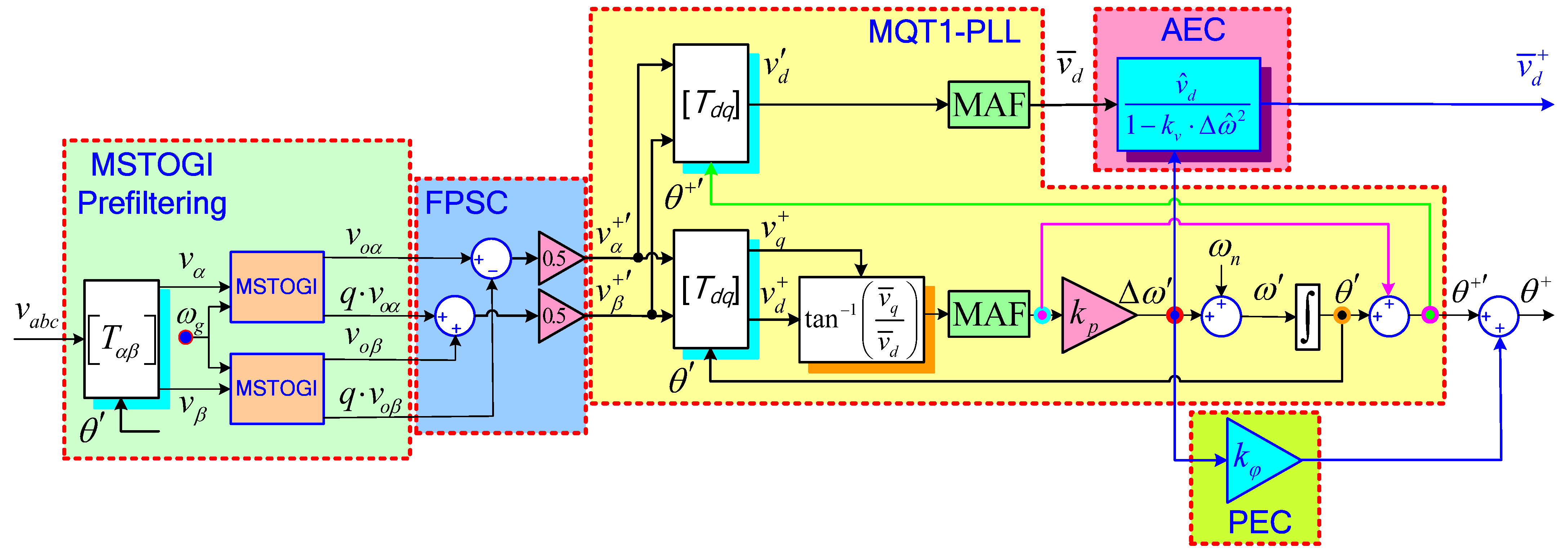
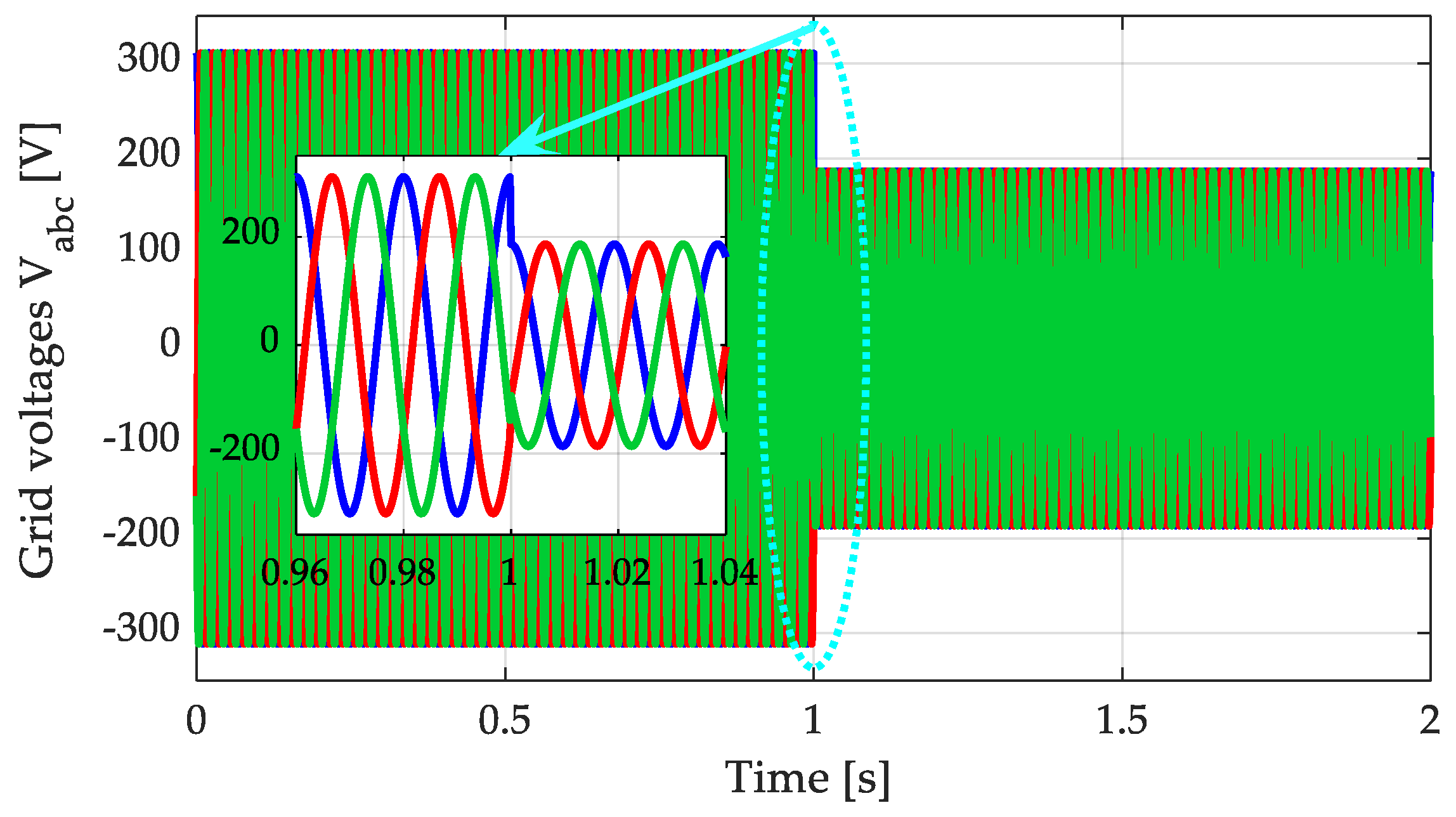
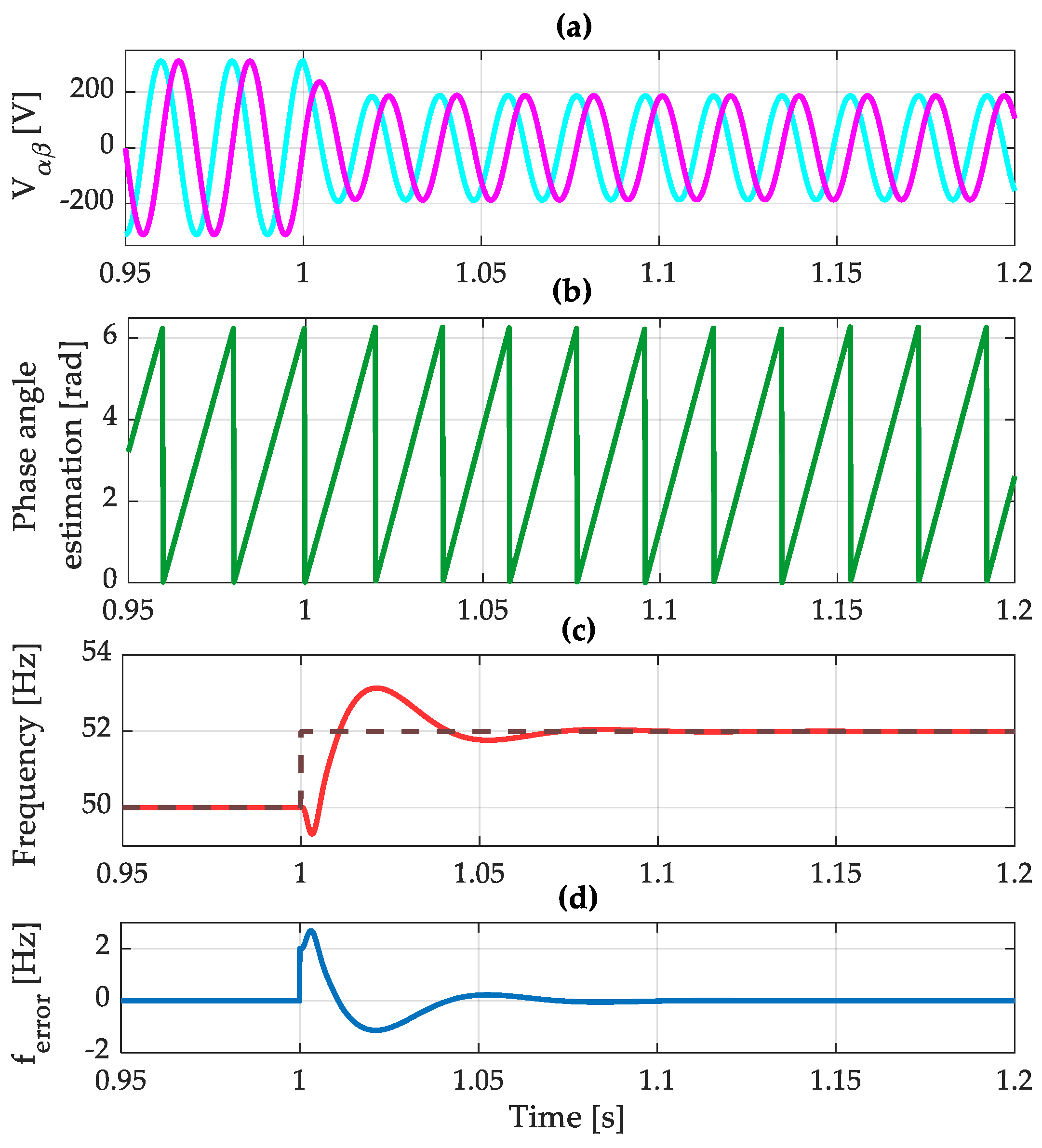


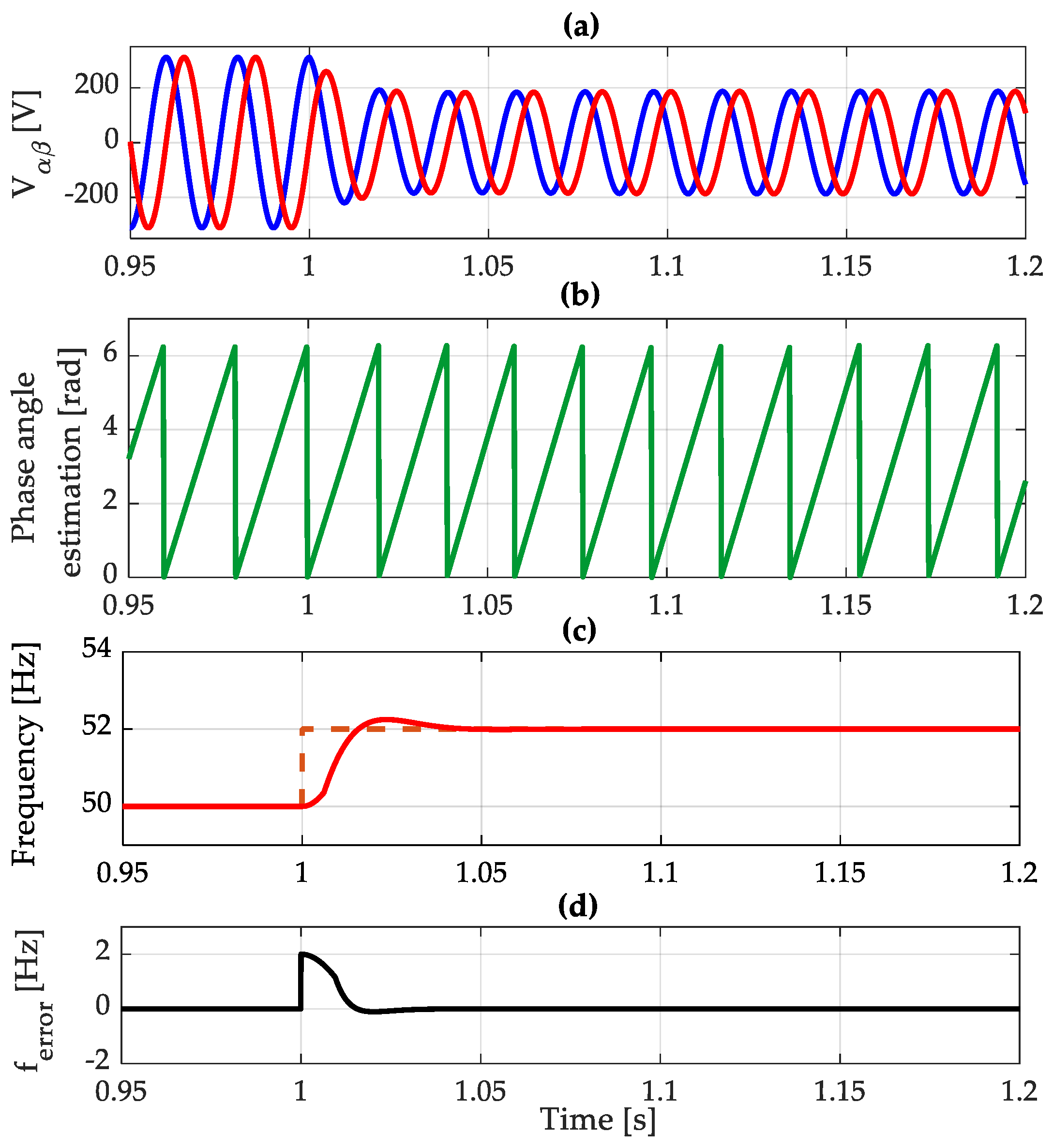
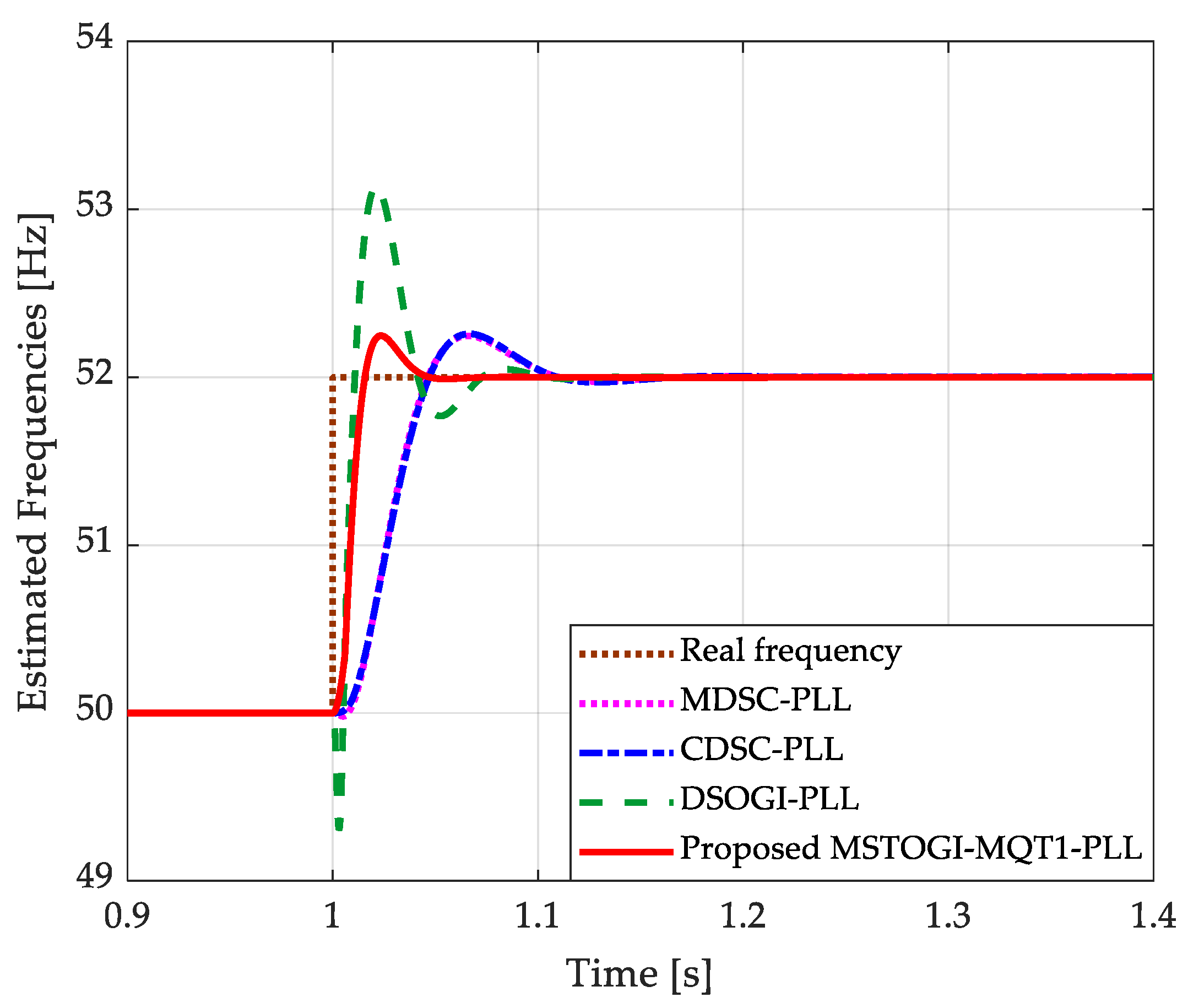
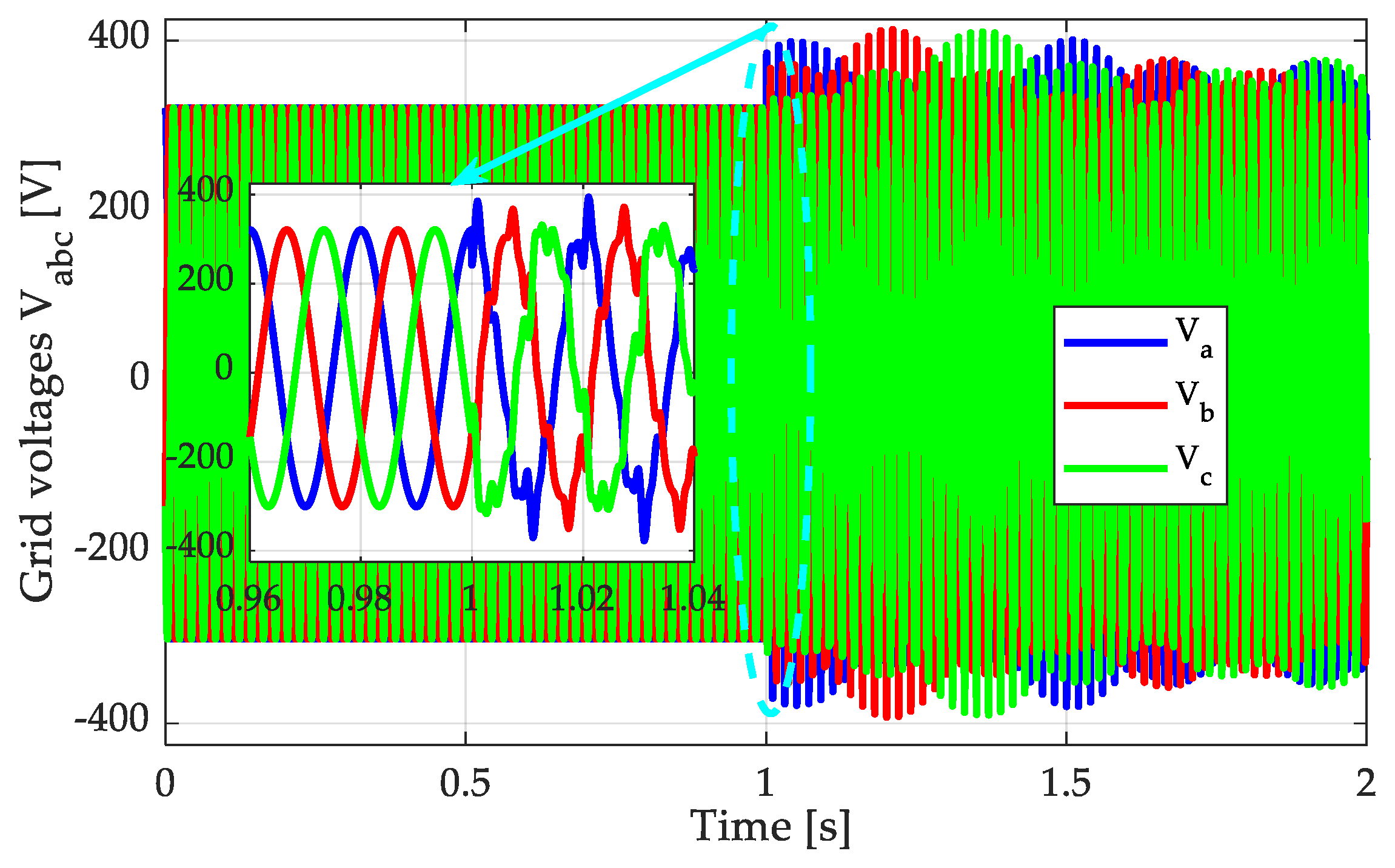
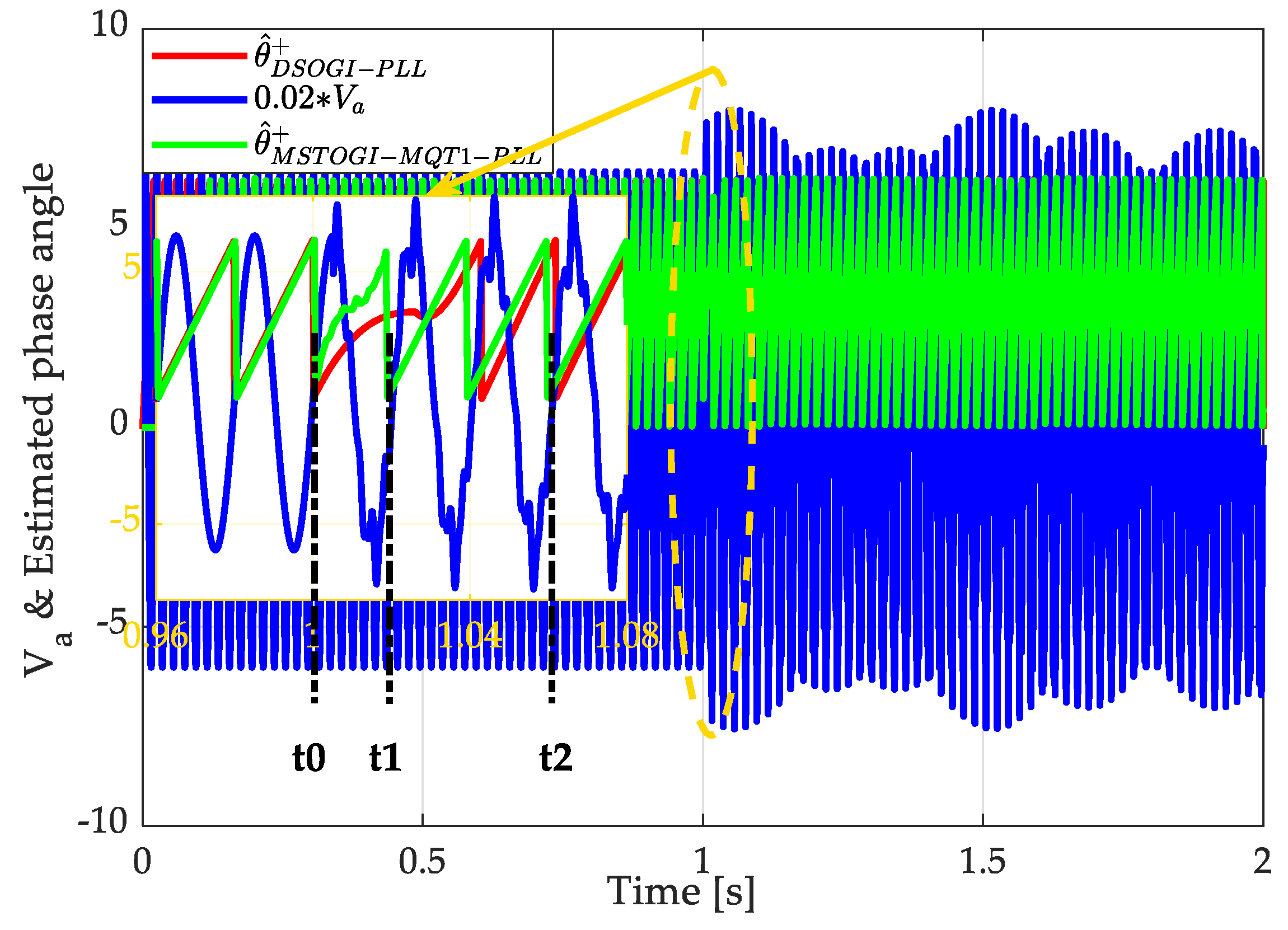
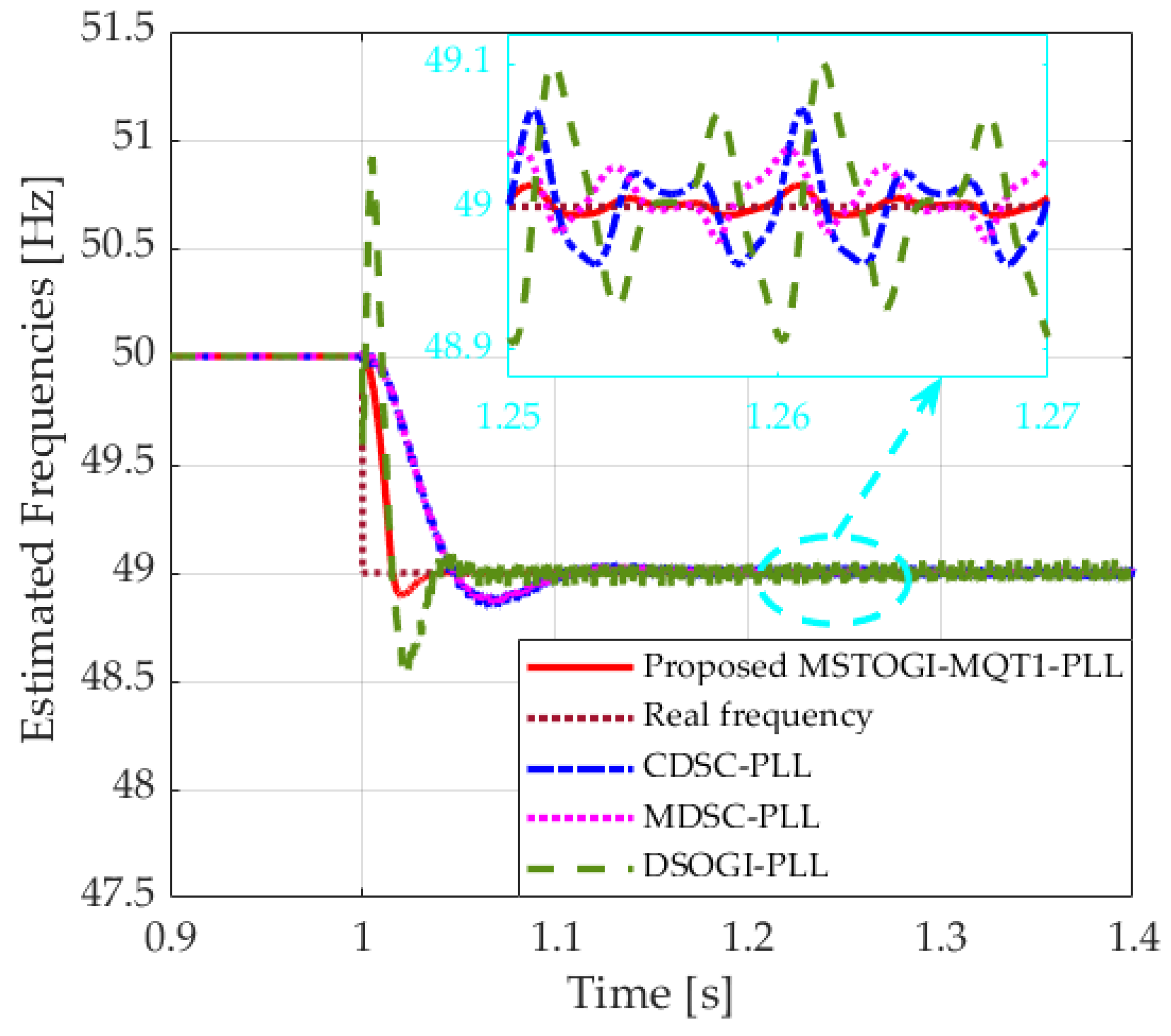


| Harmonic Order | THD (%) |
|---|---|
| 5th harmonic | 10 |
| 7th harmonic | 10 |
| 11th harmonic | 5 |
| 13th harmonic | 5 |
| # | Grid Voltages | Frequency Overshoot | |||||
|---|---|---|---|---|---|---|---|
| - | Voltage Sag | Frequency Step | Harmonics | DSOGI-PLL | MDSC-PLL | CDSC-PLL | MSTOGI-MQT1-PLL |
| Scenario 1 | Symmetrical | +2 Hz | No | +1.1346 −0.6916 | +0.2463 −0.0197 | +0.2580 −0.0313 | +0.2272 −0.1009 |
| Scenario 2 | No | −1 Hz | Yes | +0.4325 −0.4165 | +0.0085 −0.1196 | +0.0908 −0.1302 | +0 −0.1041 |
| Scenario 3 | Asymmetrical | −1 Hz | Yes | +0.4424 −0.4275 | +0.0097 −0.1373 | +0.0917 −0.1369 | +0 −0.1083 |
Publisher’s Note: MDPI stays neutral with regard to jurisdictional claims in published maps and institutional affiliations. |
© 2022 by the authors. Licensee MDPI, Basel, Switzerland. This article is an open access article distributed under the terms and conditions of the Creative Commons Attribution (CC BY) license (https://creativecommons.org/licenses/by/4.0/).
Share and Cite
Alturki, M.; Abbassi, R.; Albaker, A.; Jerbi, H. A New Hybrid Synchronization PLL Scheme for Interconnecting Renewable Energy Sources to an Abnormal Electric Grid. Mathematics 2022, 10, 1101. https://doi.org/10.3390/math10071101
Alturki M, Abbassi R, Albaker A, Jerbi H. A New Hybrid Synchronization PLL Scheme for Interconnecting Renewable Energy Sources to an Abnormal Electric Grid. Mathematics. 2022; 10(7):1101. https://doi.org/10.3390/math10071101
Chicago/Turabian StyleAlturki, Mansoor, Rabeh Abbassi, Abdullah Albaker, and Houssem Jerbi. 2022. "A New Hybrid Synchronization PLL Scheme for Interconnecting Renewable Energy Sources to an Abnormal Electric Grid" Mathematics 10, no. 7: 1101. https://doi.org/10.3390/math10071101








